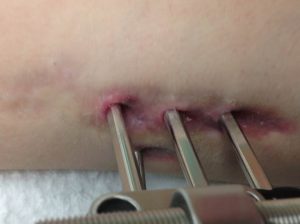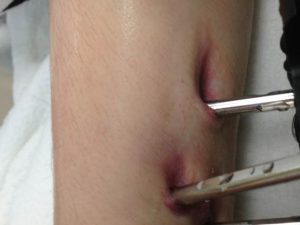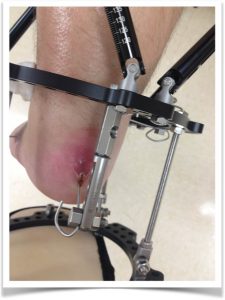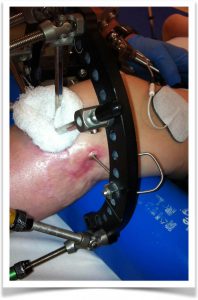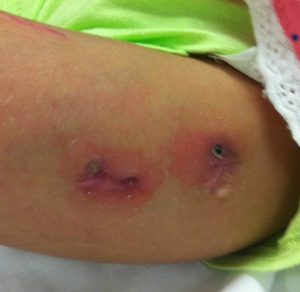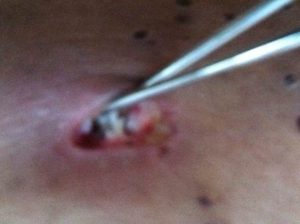Download Pin Care Patient Guide
CLEANING AND CARE
- You should wash the pin sites with soap and water while in the shower. You may use an antibacterial soap, such as Dial, to wash the pin sites and fixator.
- After showering or soaking and while the skin is still moist, use a sterile cotton tip applicator (Q-Tip) or tweezers to brush or pull off any scabs or crust surrounding the pin sites.
¬ Do NOT insert the cotton swab below the level of the skin into the pin site. - After showering, please follow your clinical instructions to:
¬ re-wrap each pin site with sterile gauze or the Acticoat octagons
¬ or leave open to air as long as the pin sites are not draining
POOLS, OCEAN, AND BATHS
- You may swim in a clean pool and/or ocean after 2 weeks once cleared by your medical team.
- Swimming in the ocean may soften any crusting.
- Epsom salts may be used in the bathwater to minimize infection and keep pin.
SIGNS AND SYMPTOMS OF PIN INFECTIONS
- Tenderness around the pin site that was not previously tender. This is often the first sign.
- Redness in the same general area (compared to other areas). Do not confuse redness from infection with the red or purple color from scar formation.
- Warmth in the same general area (compared to other areas).
- Swelling of the area may be hard or fluid-like.
- Drainage from the area. Characteristics may vary such as consistency, color, and smell.
- Remember that amber or tea-colored drainage is normal in small amounts.
- Odor is a sign that the infection has progressed.
- Temperature (fever) taken by mouth or under the arm of 101 degrees or greater. Do not take temperature within two hours of physical therapy as it may be elevated from exercising. It is possible to have a pin-site infection without an accompanying fever.
WHEN TO CONTACT MEDICAL STAFF
- It is typical for the pin sites to be pink in appearance or have a slight red discoloration to the skin. It is also typical for them to drain a clear to yellow or blood-tinged fluid on occasion.
- If you feel you are developing signs or symptoms to suggest an infection (pain, redness, warmth, tenderness, drainage, that is yellow or white in appearance, fever, etc.) please contact the office immediately at (561) 844-5255 and ask to speak to one of the medical assistants.
¬ Please take a picture of the area of concern and email it to the medical assistants and one of the clinicians will determine if antibiotics need to be started.
¬ You may be discharged home with antibiotics in the event you develop an infection.
¬ Please fill this antibiotic if you have been instructed to do so by our office. - If it is after business hours, please take a picture of the area of concern and email it to the on-call person that the call service will connect you to, (561) 844-5255.
¬ In the email, please provide the name of the patient, date of birth, pharmacy name and number, weight, and any known allergies.
Infected Pin Sites
These pin sites are confirmed infected. Treatment should be sought immediately.
It is important to keep in mind that pin site infections are a part of wearing an external fixator. It is not unusual for a patient to have at least one pin site infection. It is not necessarily a reflection on you or your care of the fixator. The important part of pin site infections is that they are easily treatable and
managed when spotted early and addressed swiftly.
MEDICAL ASSISTANTS
Dalia Hanna, MA
dhanna@paleyinstitute.org
(561) 844-5255 ext 243
Lina Kebede, MA
lkebede@paleyinstitute.org
(561) 844-5255 ext 285
PHYSICIAN ASSISTANTS/ NURSE PRACTITIONER
paleypa@paleyinstitute.org
John Robb, PA-C
Allan Loesch, PA-C
Doug Kautz, PA-C
Dayna Hagerty, FNP-C
Robert Colletta, PA-C
